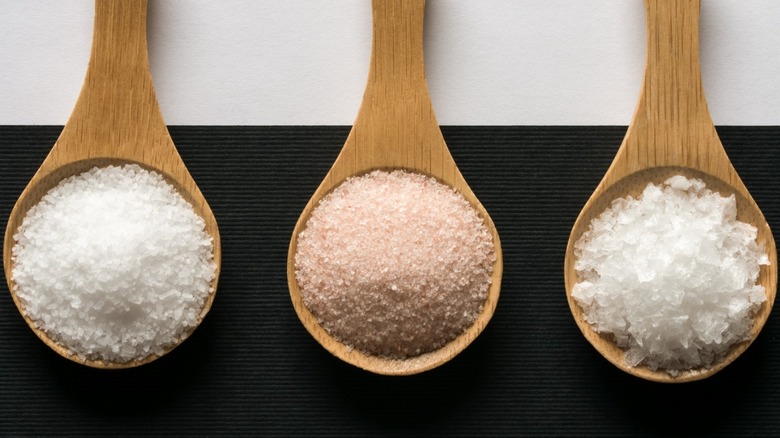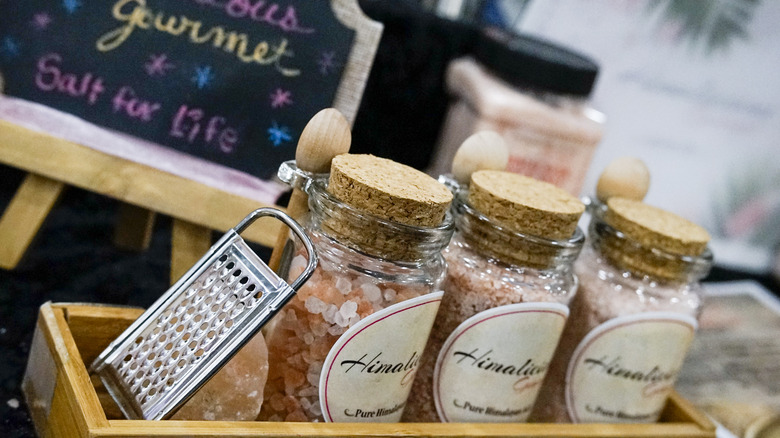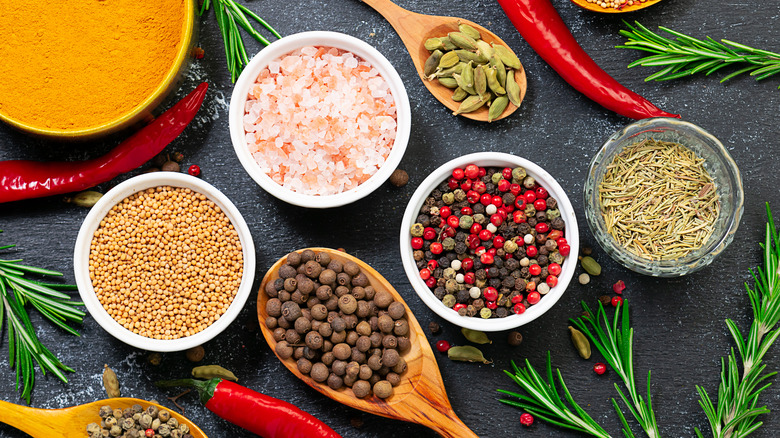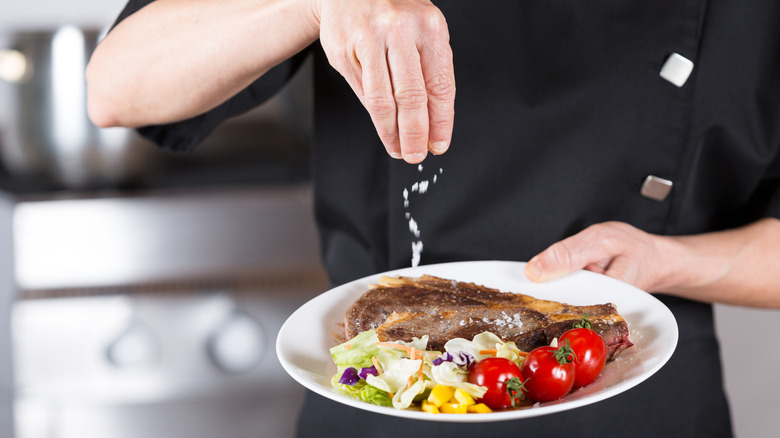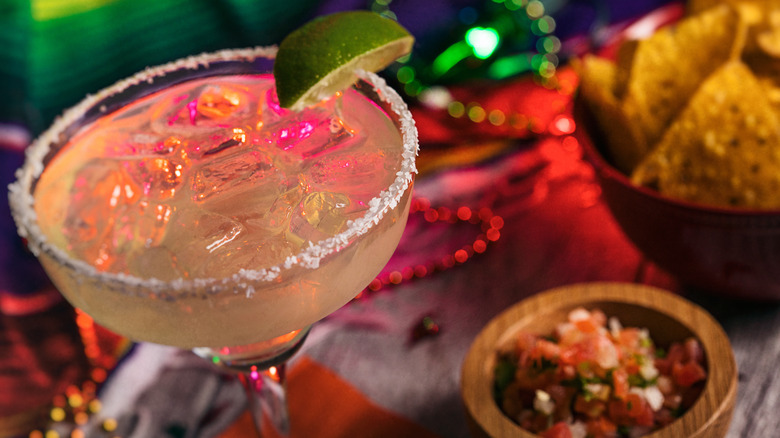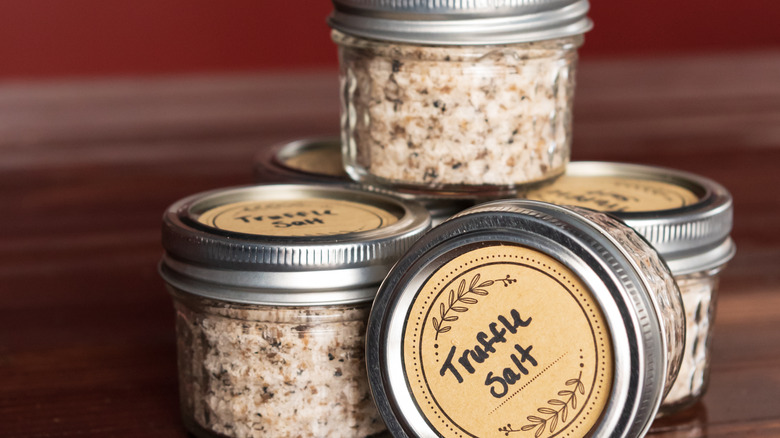What Are Gourmet Salts And Are They Worth The Price?
If you've ever complained about your food tasting bland, it's a good guess that it's lacking salt. One of five basic tastes of the human palate — sweet, salty, bitter, sour, and umami — Food Republic notes that salt is one of the oldest seasonings, with evidence of salt production going back at least 8,000 years. And while most people think about salt as being just ... salt, the flavor and texture can change based on how it's processed and the minerals associated with the region it was farmed in.
There are three primary methods to extracting salt, and even mass market salts use the same types of processes: solar evaporation, where the sun evaporates shallow pools of water, leaving the salt crystals behind; rock salt mining, where the salt is dug out of the earth; and vacuum evaporation, where salt mine deposits are pumped with water, turning it into a salty brine slurry, that is then moved into a series of large vacuum evaporators where the water is boiled off, leaving fine salt behind (per Morton's Salt).
But in addition to different types of salts based on processing and terroir, a number of "gourmet salts" are available on the market. As celebrity chef Ina Garten told Oprah Daily in June 2021, "Salt is the most important ingredient of all ... Most people think different types of salt are interchangeable, but that's not at all true."
What are gourmet salts?
Sometimes referred to as artisan salts, gourmet salts are often a step above your classic mined or evaporated coarse grain salt. Simply Recipes notes they're often referred to as "finishing salts," meaning they're meant to be used at the end of the cooking process to imbue the food — or drink — with a salty crunch, and the flavor or essence of that particular salt. As Oregon's Jacobsen Salt Co. owner Ben Jacobson told Williams-Sonoma, when he first tried finishing salts, "I was struck by how much taste they actually had! It wasn't just sodium. It was brininess, combined with a delicate crunch. The crunch would contrast with food, texturally, and then wash my mouth with flavor."
While the profusion of gourmet salts seems new, some are cuisine classics, like Fleur de Sel. According to Salt Spring Sea Salt, Fleur de Sel — "Flower of Salt" — is a kind of sodium crystal that occurs during the evaporation process of harvesting sea salt. In the right, rare conditions, a thin layer of the salty crystals rise to the surface and are harvested by hand, The Spruce Eats writes. Lower in salinity, it has a more briny, mineral flavor, Food Republic notes. While other countries produce similar crystalline salts, Fleur de Sel primarily hails from the shallow seawater pools on the Brittany coast of France. While it gained popularly with professional chefs in the early 2000s, it's been harvested in France since at least 868 C.E., per Spiceography.
How are gourmet salts made, and what do they taste like?
Gourmet salts come in a wide range of flavors and infusions. Some companies leave the fine quality salt crystals in their natural state — like Fleur de Sel or Himalayan Pink Sea Salt — leaving the strong taste of salty sea, while others add flavors or even smoke the salt.
Smoked salts are primarily made from sea salts smoked in various types of wood — no fake Liquid Smoke here. As The Salt Box writes, smoked salts can give a "flame-grilled smokiness" to the dish, and generally the salts are smoked for up to two weeks. When smoking the salt, the type of wood used will impart completely different flavors. Applewood or mesquite woods tend to give off sweet, smokey flavors, while cold-smoked Chardonnay oak can infuse the salt with the flavor of wine.
Flavored salts generally are made by infusing sea salt with flavorings. According to The Spruce Eats, there are a wide-ranging amount of already-manufactured flavors available, from heat-infusions like sriracha, ghost pepper, or green jalapeño, to more savory flavors like saffron, truffle, or vanilla. There are also wine-infused salts, as well as classic herbaceous and citrus flavors like rosemary, thyme, and lemon. The Salt Box notes that some brands separate out chili salts, those infused with heat-providing spices, and flavored salts, those mixed with herbs and other natural flavorings, but many combine the two.
How to cook with gourmet salts
The key thing when using gourmet salts is to use them at the end of the cooking process, Love Sea Salt emphasizes. Adding them during the cooking process will cause the salt to dissolve into whatever dish you're creating, losing the essence of the flavor and texture that are the whole point of using them in the first place.
But just as there are a plethora of gourmet salts available, the uses for them are as wide-ranging as your imagination. The key is choosing the right salt for the dish. A stronger flavored meal might require a coarser, more strongly flavored salt, and the opposite will be true for something more delicate. With subtle foods like fish, SaltWorks notes, gourmet salts can enhance the flavors without overwhelming the palate. They can even be mixed into or sprinkled over butter to add additional flavor and crunch.
They're not just for savory dishes, either — gourmet salts can also enhance the flavor of sweet dishes. Sea salt caramel and salty chocolates are often seen on store shelves, but it doesn't have to stop there. As SaltWorks points out, the salt flavoring can tamper overwhelming bitterness or cloying sweetness of a dessert.
Smoked salts similarly have a wide range of uses. The Salt Box notes they can add chargrilled flavoring to meats that aren't grilled or to add smoky notes to salads or soups. They can also be used as a pre-grilling rub for meats.
How to make drinks with gourmet salts
Gourmet salts aren't just for food. One culinary trend involves using gourmet salts to give depth and enhance the flavor profile of a cocktail. As San Francisco-based beverage specialist Morgan Schick told Liquor.com, "Using salt in any drink adds complexity ... It emphasizes certain flavors and can make a simple cocktail really unique, especially with cocktails that are bitter or sour."
You can use them to rim a cocktail glass, Liquor.com notes, or in the cocktail itself, to add to the cocktail's complexity. Mixologist Marcio Ramos of New York City's The Honey Well, noted to Liquor.com, "What's so intriguing about these salts is the layering effects, which makes a cocktail stand out." Experimenting with different salts and cocktails can provide unique results — a jalapeño salt spices up a margarita, or a herbal-infused salt could deepen a classic martini. Cocktails like Manhattans that are often smoke-infused in cocktail bars could get similar flavors from smoked salts, but without the hassle. Salt entrepreneur Mark Bitterman told SevenFiftyDaily that people should buy a variety of salts, "and [just] play ... you can accomplish all kinds of cool things, and, frankly, it's fun."
There are also brands that specialize in pre-made gourmet cocktail salts, and some alcohol brands are producing them as well. Craft gin-specialist Tamworth Distilling has created a Gin Salt, made with juniper, coriander, and anjelica, specifically intended to enhance the natural gin flavors.
Where to buy gourmet salts
Gourmet salts add flavorful finish to any dish, but they do come at a price. Some, like Fleur de Sel, can be especially expensive because they're harvested by hand. An 8.8-ounce jar of Fleur de Sel, for example, will set you back $14.95 at Williams-Sonoma. A 2.2-pound bag of Himalayan Pink Sea Salt, meanwhile, costs $8.99 on Amazon. And an 8.5-ounce box of Maldon Sea Salt Flakes will set you back $6.99 at Safeway. In general, you should be able to find gourmet salts at your local grocery store, though a specialty store may have more flavor options. So, are finishing salts worth the price? It's up to you, but these salts do add flavor and texture that can't be achieved with just regular table or sea salt.
You can also make flavored finishing salts at home, as long as you start with high-quality sea salt. Using a cooking process similar to making infused sugars, Ree Drummond notes on her website that the most successful ratio is approximately one teaspoon of flavoring to 1/4 cup of salt. That said, some infusions might be worth paying for if the ingredients are more expensive, like truffles, or if you want a specific flavoring that's not available in your area.
Smoked salts, however, are a more complicated process, requiring a smoker and a deft hand. Unless you're skilled with a smoker and want to experiment with a specific type of wood, leave those to the professionals.
